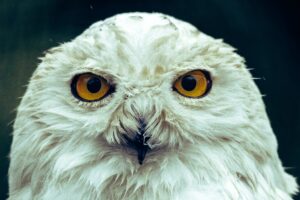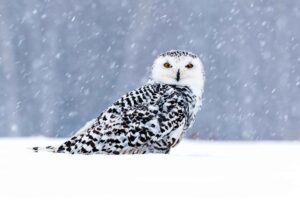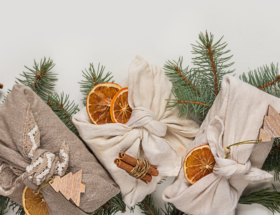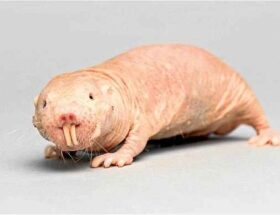I love all things Arctic. It is a strange thing that I live in the South Florida heat. I love the beauty of the bright white snow and all the arctic white furry animals. The snowy owl is one of those beauties. Although there are more than 225 species of owls, this one is my favorite. Check out the 20 snowy owls facts for kids below and fall in love with this amazing bird!



Quick and Easy Navigation
20 Snowy Owl Facts for Kids
- Snowy owls are large white polar owls with dark spots on the top of their heads going down their back and shoulders. The females have more spots than males.
- They live in the Arctic tundra of North America, Europe, and Asia. The tundra is the treeless wide-open space area of the arctic. A majority of these can be found in Alaska, Canada, and Greenland, as well as Russia and Scandinavia. Most live in the Arctic all year round, but some like to fly south for the winter.
- They have large yellow eyes and a black hooked beak they use for hunting.
- They cannot move their eyes; they turn the entire head instead.
- They have bristles in their beaks that help them sense near objects since they are far-sighted.
- They weigh between 3.5 to 6.6 lbs. Some of this is due to the dense feathers they use for insulation. Their feet are also covered with feathers to help them stay warm in the harsh arctic environment.
- They are about 20-28 inches long with a wingspan of up to 5 feet.
- The adult female is larger than the adult male.
- Unlike most owls that are nocturnal, the snowy owl is diurnal and is active during the day.
- They sit close to the ground on rocks or right on the snow.
- They eat small rodents, lemmings, and insects.
- They are great silent hunters. Their flight feathers have serrated edges which help reduce the noise produced by wing flapping. This feature allows them to go undetected by potential prey.
- They sit and wait for long periods. They have fantastic hearing and can hear a rodent under the snow.
- When a sound is detected, they dive into the snow, catch their prey with their sharp talons, and eat it whole.
- The average life span in the wild is ten years.
- They are very vigilant and can see any threat within seconds.
- They build nests on the grounds or rocks, and the female lays between 3 and 11 eggs. The baby owlets hatch after a month.
- They do not make good pets; they are large, strong, and have a fierce bite.
- Per the IUCN Red List, this owl is in Vulnerable status, and the population is decreasing. There are about 28,000 left in the world.
- Why are they important? Snowy owls play an essential role in controlling the number of rodents in the Arctic tundra environment. One snowy owl can eat up to 1,600 rodents in a year.
Source: National Geographic for Kids
Snowy Owls Facts Video For Kids
Snowy Owl Facts For Kids FAQ
Q: What are some interesting facts about snowy owls?
A: Snowy owls, also known as Bubo scandiacus, are large white owls that are typically found in the Arctic. They are known to lay from 3 to 11 eggs and mate for life. Snowy owls can fly and are often found hunting for prey in their natural habitat.
Q: Where do snowy owls prefer to nest?
A: Snowy owls prefer to nest on the ground, and their breeding season is usually during the summer months in the Arctic tundra.
Q: How many snowy owls are typically found in a nest?
A: Snowy owls can have anywhere from 3 to 11 eggs, and the female snowy owl is responsible for incubating the eggs until they hatch.
Q: Do snowy owls mate for life?
A: Yes, snowy owls are known to be monogamous and typically mate for life.
Q: What do snowy owls eat?
A: Snowy owls are carnivorous and primarily feed on small mammals such as lemmings and arctic hares. They have also been known to prey on birds and fish.
Q: Do snowy owls migrate?
A: Yes, snowy owls are known to migrate based on food availability and environmental conditions. They may travel long distances in search of food during the winter months.
Q: What are some distinctive markings of snowy owls?
A: Snowy owls are often recognized by their white plumage with scattered black markings. Male snowy owls tend to be whiter than females, who have more extensive markings on their feathers.
Q: Are there any interesting facts about snowy owls and their nesting habits?
A: Snowy owls are known to build their nests on the ground in open areas, and they may use scrapes or depressions in the ground as their nesting sites.
Q: Are snowy owls found in locations other than the Arctic?
A: Snowy owls are also found in some northern regions of North America, particularly during the winter months when they migrate south in search of food.
Q: What are some fascinating behaviors exhibited by snowy owls?
A: Snowy owls are often observed perching on elevated locations, such as hills or rocks, in search of prey. They are known for their silent flight and powerful hunting abilities, capturing their prey whole with their sharp talons.










[…] Birds, Wildlife […]
[…] Animal Facts, Birds […]